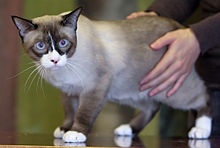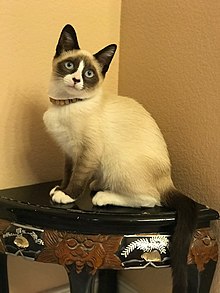Breed of cat
| Snowshoe Cat | |
|---|---|
 | |
| Common nicknames | Snowshoe Siamese, Silver Laces |
| Origin | |
| Breed standards | |
| FIFe | standard |
| TICA | standard |
| WCF | standard |
| ACFA/CAA | standard |
| GCCF | standard |
| Domestic cat (Felis catus) | |
The Snowshoe is a rare breed of domestic cat originating in the United States of America in the 1960s. The Snowshoe is a short-haired bicolour colourpoint breed. Snowshoes were first produced when a Siamese breeder's cat gave birth to three kittens with white feet. The breeder, Dorothy Hinds-Daugherty, then began a breeding program to produce what were originally called "Silver Laces", crossing the strangely marked Siamese cats with bicolour American Shorthair cats and other breeds. Despite having existed for 45 years, Snowshoes are rare due to the difficulty of reproducing the correct coat markings.
History

In the 1960s, a cat owned by Siamese cat breeder Dorothy Hinds-Daugherty produced a litter of Siamese kittens in Philadelphia, Pennsylvania. Three of the kittens had unique markings, consisting of white points and feet. Intrigued by their looks, she began working to breed cats like them, using seal point Siamese with bicolour American Shorthairs. The offspring of those cats lacked the Siamese points, but by breeding the offspring to Siamese cats, the desired look was accomplished. Hinds-Daugherty named the breed "Snowshoe" because of their white feet. Hinds-Daugherty promoted the Snowshoe at local cats shows, though they were not recognised at the time. Hinds-Daughtery eventually abandoned the Snowshoe breeding program, and it was taken up by Vikki Olander.
Olander wrote the first breed standard for the Snowshoe, and succeeded in obtaining the Cat Fanciers Federation (CFF) and the American Cat Association's (ACA) "experimental breed" status for the Snowshoe in 1974. However, by 1977, Olander was the last breeder of the Snowshoe in the United States. After struggling to keep the breed alive, Olander was contacted by Jim Hoffman and Georgia Kuhnell, who were interested in the breed. Other breeders joined Olander, Hoffman, and Kuhnell, and they obtained the champion status from the CFF in 1983. In 1989, Olander left the program, as her fiancé was allergic to cats. However, by then the Snowshoe had a strong following, and the breed attained champion status with the American Cat Fanciers Association (ACFA) in 1990 and was recognised by The International Cat Association (TICA) in 1993. Currently, breeders work to attain acceptance with the Cat Fanciers Association, but struggle with the lack of cats and breeders needed for the association's requirements.
Snowshoes are also fully recognised by the Fédération Internationale Féline (FIFe), and the Cat Fanciers Federation.
Popularity and breeding

The Snowshoe is a rare breed, partly due to the difficulty of breeding cats with markings and patterns that conform well to breed standards. The Snowshoe's pattern relies on recessive genes and other factors to produce desired results. One gene, which causes the "V" facial pattern, is an example of incomplete dominance. If the offspring produced has two dominant genes for the marking, then the feature will be larger than a cat with one dominant gene. However, other factors may influence the feature, which makes it difficult to predict the outcome. Another issue is the white boots, which can be caused by a piebalding gene or a gloving gene. The genes are difficult to control, and many cats' boots extend too far up the leg, do not reach far enough up the leg, or the cat completely lacks white. As such, pet-quality Snowshoes usually have too much white, too little white, or white features are mismarked. The cats' body type further complicates breeding, as the breeder must achieve the correct head shape and ear set, while still maintaining the body structure of the American Shorthair and the length of the Siamese.
Characteristics

Anatomy
The ear size ranges from medium to medium-large with slightly rounded tips. The head may be triangular, however can be an "applehead" shape with a traditional cat look. The short-haired coat consists of solid and white patterns. Points (ears, tail, face-mask and sometimes legs) are solid black-based colours. White patterns vary, typically falling along the face, chest, stomach, and paws. The body is an even colouration, subtle shading to point colour on back, shoulders and hips; toning to a lighter shade near chest and stomach. Paw pads may be white, point colour, flesh tone, or mottled. Their colour will darken with age, even to the point of turning a chocolate brown shade. The eyes are always blue. The tail is medium-sized. Snowshoe cats come in blue, lilac, lynx, fawn, chocolate, and seal points. The Snowshoe is a medium-large cat and its body longer than other cat breeds, with many males reaching 6 kg (14 lbs) or more.
Coat

In registries and cat associations, the recognised Snowshoe coat color is point coloration, featuring a light body color and darker ears, face, legs, and tail. Unlike standard Colorpoint Shorthairs, however, Snowshoe point gradients end in sharply-contrasting white tips on the paws and nose/muzzle. The ACFA recognises seal (black) and blue point colouration, while the FIFe recognises seal (black), blue, chocolate, red, cream, cinnamon, and fawn point colouration. Additionally, the FIFe recognises the colours in tortoiseshell, tabby, and tortoiseshell-tabby coat patterns. TICA recognises all pointed colours. Snowshoe kittens are born white, and markings appear within 1 to 3 weeks. Each Snowshoe has a pattern unique to the individual cat.
The Snowshoe's coat should be of medium to short in length, and should be bright and smooth with no noticeable undercoat. It is considered a fault within cat associations if the Snowshoe has a plush or double coat. The Snowshoe's coat undergoes seasonal changes and does not require much grooming.
Personality
Snowshoes are generally affectionate, sweet-tempered, and mellow. They enjoy the company of humans and being given attention, and are compatible with children and other pets. Snowshoes are very social and docile, and show great devotion and love towards their owners. Consequently, the cats of this breed dislike being left alone for long periods of time and are able to cope with working hours better if they have another cat companion. The cats are also noted as being intelligent; they can learn to open various types of doors, and can be taught tricks, especially fetch. Snowshoes also enjoy water, particularly running water, and may on occasion swim.
Health
In a review of over 5,000 cases of urate urolithiasis the Snowshoe was over-represented, with three recorded cases out of a population of 16.
References
- "Cat Lovers Only – Snowshoe". Retrieved August 28, 2011.
- ^ "Animal Planet – Snowshoe". Animal Planet. Archived from the original on May 7, 2006. Retrieved April 3, 2009.
- ^ "Iams – Snowshoe". Iams. Archived from the original on September 2, 2008. Retrieved April 3, 2009.
- "Breed standards (Fédération Internationale Féline)". Fédération Internationale Féline. Archived from the original on February 19, 2010. Retrieved August 2, 2010.
- "SNOWSHOE" (PDF). Archived (PDF) from the original on July 26, 2023. Retrieved December 11, 2023.
- "the Snowshoe". American Cat Fanciers Association. Archived from the original on January 2, 2010. Retrieved May 3, 2009.
- ^ "Snowshoe" (PDF). The International Cat Association. Retrieved December 11, 2023.
- ^ "FIFe – Snowshoe" (PDF). Fédération Internationale Féline. Archived (PDF) from the original on December 29, 2015. Retrieved March 25, 2011.
- ^ "the ACFA Snowshoe Standard". American Cat Fanciers Association. Archived from the original on December 30, 2008. Retrieved May 3, 2009.
- ^ Harper, Lee; White, Joyce (2008). The Complete Illustrated Encyclopedia of Cats. New York: Flame Tree Publishing. p. 242. ISBN 978-1-4351-0540-9.
- Albasan, H.; Osborne, C. A.; Lulich, J. P.; Lekcharoensuk, C. (2012). "Risk factors for urate uroliths in cats". Journal of the American Veterinary Medical Association. 240 (7): 842–847. doi:10.2460/javma.240.7.842. PMID 22443437.